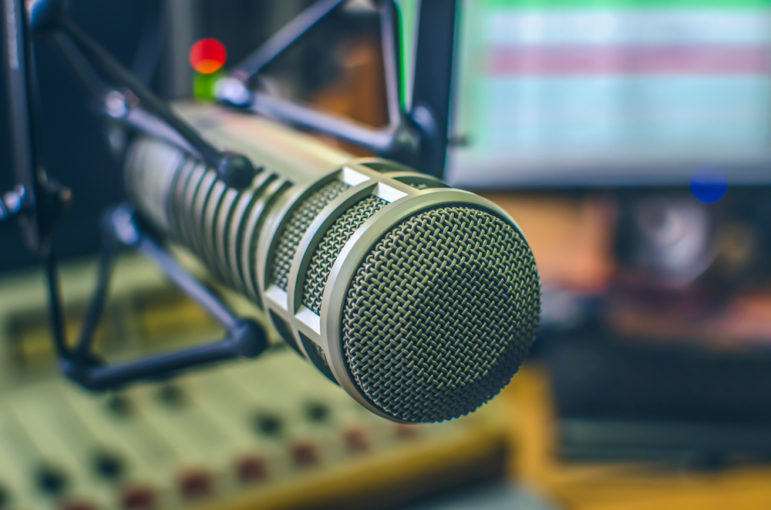

Image: Shutterstock
Going Multilingual — The New Frontier of Podcasting?
Editor’s note: The KBR editorial team secured support from GIJN’s Investigative Journalism Media Assessment Program (IJ-MAP) to work with Reber and GIJN Advisory Services to develop its investigative podcast “Disclose,” which developed the child marriage series.
It took the broadcaster KBR around a year to make an investigative podcast about child marriage in Indonesia. The series — Dipaksa Kawin, or Forced to Marry — was a hit with more than half-a-million listens.
But instead of letting the story end when the show reached its finale in its native Bahasa Indonesian, the team behind it collaborated with a group in the Philippines to produce a version in English. That meant that the story of Rasminah, a child bride forced to marry when she was 13, and others like her, has now traveled to audiences in other parts of Asia.
Hearing Forced to Marry in another language was a dream come true for Citra Dyah Prastuti, editor-in-chief of KBR Indonesia. “I believe the story is super important. Not only for Indonesia but also for the region and the rest of the world,” she said.
The series recently won an award for the Best Journalistic Work About Children in the radio category by UNICEF and the Alliance of Independent Journalists – Indonesia.
In August, Rashminah passed away from cancer. She was 38 years old and had been forced to marry three times by the time she turned 20. “This is how we keep Rashminah’s story alive. This was her legacy,” said Prastuti.
Breaking Language Barriers, Finding New Audiences
The global boom in audio streaming signals an opportunity for investigative journalists to reach wider audiences by creating multilingual translations of their podcasts, either released simultaneously across different markets or at a later time after the original publication.
Of course, KBR is not the first to do this: The Irish true crime podcast The Nobody Zone offered a deeply disquieting investigation into a serial killer made in five different languages: English, Irish, Danish, German, and Spanish. When it was made in 2020, it topped the Irish podcast chart, but more importantly, perhaps, gained nearly five million global listens.
Another award-winning podcast, The Forgotten Women of Juárez, about a spate of femicides in the Mexican border city, was created in English then adapted in three languages: Spanish, German, and Danish.
But there are a number of important questions reporters and producers need to consider before deciding if their podcast might work well in translation. Key questions include: What languages do you translate into? What about interviews with participants, should these remain in the original language or be voiced over? What added material is needed to allow a podcast to travel beyond a country’s borders? And can you be authentic in translation?
Prastuti said that for the English version of their podcast, broadcast under the title Rasminah, The Last Victim, and made with the Philippine podcast production company, Pumapodcast, they had to add more context to explain Indonesian laws and some court scenes so that the podcast “would make sense to the rest of the world.”
But it was important not to entirely replace the voice of their central character. Instead, an English narrator is heard speaking over Rashminah’s voice.
“We didn’t remove the original voice of Rasminah speaking in Bahasa Indonesia, [but] put an English translation over it to keep the intimate confessional tone,” she said. “So listeners can hear that this is a mother, a child forced into a child marriage.”
Roby Alampay, founder, chairman, and editor-at-large of Pumapodcast, told GIJN there were many elements in Rasminah’s story that Filipino audiences — and others — can relate to: family ties, protecting children, and love. “These are universal themes and with the intimacy of podcasts and the power of listening, you give listeners a space to reflect on these stories,” he said.
The benefits of going multilingual go beyond getting more ears tuned in to your story. It’s also about cross-border collaborations with other journalists who believe in the draw of an immersive audio story that, like good journalism, is well-researched and well-told.
“Podcasts serve as a portal to let audiences experience your story,” Alampay said. “There’s a shared emotion among those of us in the podcast community who have made a bet on the power of listening.”
“Going multilingual is not exactly the new trend because not enough people are doing it yet, but it is definitely the new frontier,” said Susanne Reber, co-founder of Reveal, the first investigative radio podcast in the US, and the executive producer of Piz Gloria Productions, which specializes in longform audio and global strategic consulting in storytelling.
Finding the Funds to Produce Multilingual Podcasts
While producing podcasts is generally less expensive than producing video, the cost of re-scripting and re-recording translations may not be something that many newsrooms will be willing to invest in — or experiment with.
“Where the heck are we going to get the money to produce it? That’s the biggest question in all of journalism,” said Reber, who was a consultant on the KBR podcast. But, she said, perhaps those working in podcasts need to think of the positives of multilingual versioning.
“There’s all this collaborative energy on: ‘Let’s report the story and get it out in different outlets.’ Maybe it’s time to flip that around to: ‘Let’s get together with a story, make it multilingual, and do it in different languages,’” she said.
Citing the fact that podcasts skew towards a younger audience, who might not be inclined to read longform investigative reports, might help build a case to add podcasts to the investigative story production mix, Reber added. “Editors are always saying we need to get a younger audience in. Well, here they are, already tuning in to podcasts.”

Reber (left), and Prastuti (right) speak on a podcasts panel at GIJC23. Image: Kholikul Alim for GIJN
According to a recent Reuters Institute of Journalism study, the audience profile of podcast listeners “is extremely interesting to publishers and to advertisers [since they] tend to be richer, better educated, and crucially much younger.”
The growth in this field is also of interest. Some 42% of Americans over the age of 12 listened to a podcast in the last month, a new all-time high. While those who count as “weekly podcast listeners” now tune in to an average of nine podcasts in a week, said Reber, sharing data from the 2023 Infinite Dial Study, the longest-running survey of US digital consumer behavior.
But listeners’ growing attachment to podcasts isn’t limited to the US.
Citing data from consumer insight polling body, YouGov, Reber shared that half of Mexicans (52%) and Brazilians (51%) listen to podcasts for at least an hour per week. South Africa has the highest rate of podcast listening of all global markets at 69%, followed closely by Saudi Arabia at 67%. In Indonesia, an estimated 63% of people spend an hour or more listening to podcasts every week. All of which hints at a global market for those able to master the language question.
What Makes a Translatable Podcast?
Thinking about going multilingual with your podcast? Here are some key considerations before deciding if your podcast might travel.
- Characters: One non-negotiable is characters whose stories are relatable and whose storytelling skills are so good that listeners can’t help but imagine themselves stepping into the protagonist’s world – even if that is far from their own. “It's very exciting to know that audiences in different countries or different language groups will hear that story and experience the characters’ point of view within their own cultural context. It amplifies the audience not just in numbers, but in terms of authenticity for the listener,” said Reber.
- Plot: One reason that true crime podcasts are often so popular internationally is because they are built on what Reber calls a “classic quest arc” or a plot that revolves around adversity. It doesn’t matter if the story takes place in the swanky neighborhoods of New York or the dense forests of the Amazon, a story of overcoming is a universal experience. “Listeners need to feel that they are rooting for the characters to overcome challenges,” said Reber.
- Journalist as character and narrator: A lot of listeners stay tuned to investigative podcasts because the journalist as narrator takes them on an audio journey of plot twists, turns, and cliffhangers that leave them hooked. In cases where podcasts travel from one language to another and where local contexts need more background and explanation, the role of the journalist extends from being a narrator to a cultural translator that connects different worlds. “As truth finders, listeners rely on the journalist/narrator to actually find stuff out that they can't. They want to know what you think, they might even want to know what you're feeling, and so give a layer of your personality to the podcast,” Reber explained.
- Collaborators: Reber, Prastuti, and Alampay all agree that the secret sauce to a podcast going multilingual is finding great collaborators. Reber is currently working on a multilingual project with Paris-based podcast producer Ochenta Studio, an organization that focuses entirely on multilingual productions. The team of producers bring a wide range of editorial and cultural experience to the table and “together we can ensure the speaking style of the podcast series translates into multiple languages,” said Reber. Alampay and Prustati noted that partnerships and collaborations allow journalists to generate and aggregate content and reach wider audiences. “But you have to have the right partner. Someone who has the same vision for your podcast,” Prustati said.
- Experiment with other platforms such as graphic novels to help audiences understand the podcast: For a podcast investigation on the scamming of Indian workers in the tech industry in California called Techsploitation, Reveal and The Center for Investigative Reporting, where Reber was an executive producer, created graphic novels in multiple languages to go along with the podcast. The story was republished in India and in Brazil where it was translated to Portuguese. Speech bubbles in a text card or a graphic novel can go a long way in communicating multilingual storylines.
What About AI?
Developments in AI technology could soon make it easier for podcast creators to translate their content for audiences around the world. Spotify recently launched a voice generation technology that promises to come up with translations that “match the creator’s own voice” and maintain distinctive speech inflections.
The audio giant has already produced pilot episodes to road test the AI-powered voice translations in languages like Spanish, French, and German with well-known podcast hosts, like actor and comedian Dax Shepherd. The new podcast from Trevor Noah, former host of the The Daily Show, which launched in November, is slated to be next. Could investigative podcasts follow?
For Alampay, the infusion of technology such as AI is inevitable — but journalists must now be able manage the disruption. Reber agrees, but sounds a note of caution: “For now I would say go ahead and experiment, try it out, but I would caution against 100% AI in a project that also needs to be bulletproof in terms of editorial demands and legal vetting."
Watch the full GIJC23 panel video on Producing the Investigative Podcast.
 Ana P. Santos is a journalist with over 10 years of experience reporting on gender issues related to sexual reproductive health, HIV, and sexual violence. As the Pulitzer Center 2014 Persephone Miel Fellow and grantee, she has reported on labor migration in Europe and the Middle East. Her work has been published by Rappler, DW Germany, The Atlantic, and The Los Angeles Times.
Ana P. Santos is a journalist with over 10 years of experience reporting on gender issues related to sexual reproductive health, HIV, and sexual violence. As the Pulitzer Center 2014 Persephone Miel Fellow and grantee, she has reported on labor migration in Europe and the Middle East. Her work has been published by Rappler, DW Germany, The Atlantic, and The Los Angeles Times.










